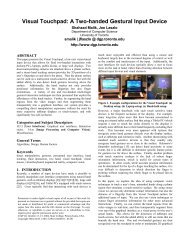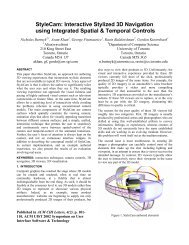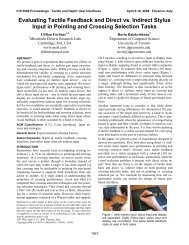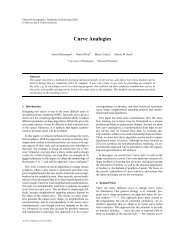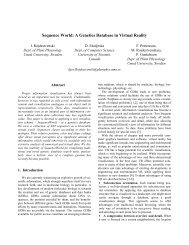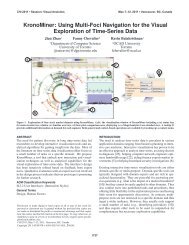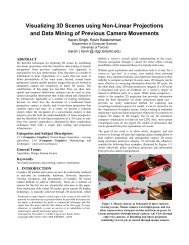Designing Interactive Life Story Multimedia for a Family Affected by ...
Designing Interactive Life Story Multimedia for a Family Affected by ...
Designing Interactive Life Story Multimedia for a Family Affected by ...
Create successful ePaper yourself
Turn your PDF publications into a flip-book with our unique Google optimized e-Paper software.
CHI 2005 | Late Breaking Results: Posters<br />
April 2-7 | Portland, Oregon, USA<br />
<strong>Designing</strong> <strong>Interactive</strong> <strong>Life</strong> <strong>Story</strong> <strong>Multimedia</strong> <strong>for</strong> a <strong>Family</strong><br />
<strong>Affected</strong> <strong>by</strong> Alzheimer’s Disease: A Case Study<br />
Tira Cohene, Ron Baecker & Elsa Marziali<br />
University of Toronto and The Baycrest Centre <strong>for</strong> Geriatric Care<br />
Toronto, Ontario Canada<br />
tcohene@dgp.utoronto.ca, rmb@kmdi.utoronto.ca, elsa.marzial@utoronto.ca<br />
ABSTRACT<br />
In this paper we present a design project involving primary<br />
end users who have declining cognitive abilities such as<br />
memory, communication, and problem solving. We are<br />
designing interactive multimedia with personalized life<br />
stories <strong>for</strong> individuals with Alzheimer’s disease. We<br />
conducted a case study to discover and address the design<br />
challenges <strong>for</strong> this project. A particular challenge is a<br />
limited ability to communicate with the primary end users.<br />
In this paper, we present design methods that take this<br />
challenge into consideration. Our goal is to contribute<br />
insight into designing <strong>for</strong> users with cognitive disabilities,<br />
and to present methodologies that are useful <strong>for</strong> designers<br />
who have a limited ability to interact or communicate with<br />
end users.<br />
Author Keywords<br />
User-centered design, design methods, Alzheimer’s disease,<br />
intervention, reminiscence, multimedia, life stories<br />
ACM Classification Keywords<br />
K.4.2 [Computers Milieux]: Social Issues — Assistive<br />
technologies <strong>for</strong> persons with disabilities, H.5.2.<br />
[In<strong>for</strong>mation Interfaces and presentation]: User Interfaces –<br />
Theory and methods, user-centered design<br />
INTRODUCTION<br />
The human-computer interaction community has researched<br />
many methods <strong>for</strong> communicating with stakeholders and<br />
end users in order to conduct user-centered design.<br />
Interviews, ethnography, and participatory design involve<br />
rich interaction and communication with participants<br />
[8,9,12,17]. However, in some design projects there are<br />
obstacles that prevent designers from having sufficient<br />
interaction or communication with participants. Differing<br />
languages, locations, and cultures are examples of such<br />
obstacles. In addition, there may be privacy issues that<br />
prevent direct communication with end users. In this paper,<br />
we shall discuss the case of end users with significantly<br />
impaired cognitive abilities.<br />
Impaired cognition affects a range of thinking abilities that<br />
are often taken <strong>for</strong> granted. These lead to communication<br />
Copyright is held <strong>by</strong> the author/owner(s).<br />
CHI 2005, April 2–7, 2005, Portland, Oregon, USA.<br />
ACM 1-59593-002-7/05/0004.<br />
and interaction obstacles that make many design methods<br />
impractical. Adaptations to these methods can help<br />
designers conduct the needed research to gain insight about<br />
their users. In this paper we recount our atypical use of<br />
research methods in the early design stages of a<br />
personalized life story multimedia system <strong>for</strong> individuals<br />
with Alzheimer’s disease.<br />
Alzheimer’s disease (AD) is a degenerative brain disease<br />
that causes the gradual loss of brain cells [1]. This leads to<br />
the decline of cognitive abilities such as memory, language,<br />
communication, problem solving, reasoning and judgment.<br />
As time progresses the severity of the symptoms increases<br />
and the disease advances through the early, mid and late<br />
stages. The expression of the symptoms can range <strong>for</strong> each<br />
individual and at each stage. AD affects one in ten North<br />
Americans above the age of 65, and nearly one half of the<br />
population over the age of 85. Due to the aging population,<br />
the diagnosis rate is expected to triple <strong>by</strong> 2050 [1].<br />
Our memories are important because they help shape our<br />
experiences, our relationships, and our sense of self. The<br />
loss of them can be devastating and can cause changes in<br />
personality and behaviour [1,11,14,19]. In addition to these<br />
changes, individuals with AD increasingly become<br />
dependent on a caregiver <strong>for</strong> activities of daily living. Thus<br />
the caregiver, who is often a family member, is also very<br />
much affected <strong>by</strong> the disease [1,2,4,11].<br />
In order to help cope with these issues, health care<br />
communities offer intervention methods, which are <strong>for</strong>ms<br />
of non-medicinal treatment or support. They may focus on<br />
memory training, memory support, assisting life aspects<br />
strained <strong>by</strong> memory loss, or facilitating the responsibilities<br />
of the caregivers. Intervention can enhance the well being<br />
of individuals’ lives [11,16] and in some cases it can slow<br />
down the progress of the disease [18]. Reminiscent therapy<br />
is an example of an intervention activity that can reveal and<br />
support a person’s identity. Even the family can participate<br />
and play a major role to support their relative [14,19].<br />
Most intervention technology created <strong>for</strong> people with<br />
cognitive disabilities is designed to make up <strong>for</strong> cognitive<br />
losses [13]. These are often referred to as Assistive<br />
Technology <strong>for</strong> Cognition (ATC). To date, little attention<br />
has been given to the development of psychosocial<br />
technological interventions. Elders with cognitive decline<br />
1300
CHI 2005 | Late Breaking Results: Posters<br />
can benefit from social support tools, and recent<br />
ethnographic research provides insight into the design of<br />
such systems [15]. Several intervention technologies focus<br />
on supporting the caregiver, such as specialized telephone<br />
and video conferencing applications [2,4].<br />
Other related work includes CIRCA (Computer <strong>Interactive</strong><br />
Reminiscence and Conversation Aid) [7], which explores<br />
the effects of interactive multimedia on AD individuals.<br />
CIRCA employs generic and non-personalized media to<br />
stimulate conversation in reminiscent therapy sessions. We<br />
are broadening this research <strong>by</strong> studying the effects of<br />
customized, personal life stories on the overall well being<br />
of the individual. A distinguishing research question in our<br />
early design is how can we elicit the necessary in<strong>for</strong>mation<br />
and requirements <strong>for</strong> a personal life story system.<br />
In September 2004 we began a project to create personal<br />
life stories <strong>for</strong> families affected <strong>by</strong> AD. The project is based<br />
on previous work that studies the effects of viewing VHS<br />
video life stories [14]. We are conducting the research at<br />
the Baycrest Centre <strong>for</strong> Geriatric Care in Toronto, Canada<br />
with a multidisciplinary team of social workers, interaction<br />
designers, health care providers and participating families.<br />
The multimedia content includes digital video, images,<br />
photographs, and audio. <strong>Interactive</strong> components allow the<br />
individual to actively participate with the multimedia.<br />
Our hypothesis is that the intervention technology will<br />
provide stimulation while rein<strong>for</strong>cing the individual’s<br />
positive self-identity. Our objectives are to evaluate any<br />
resulting stimulation from this activity, evaluate the<br />
individual’s mood and behaviours throughout the duration<br />
of the project, and to study the nature of the interaction of<br />
the AD participant with the interactive media.<br />
A significant challenge <strong>for</strong> the user-centered design of our<br />
project is our unique user group. Short-term memory loss is<br />
one of the most significant symptoms. Other symptoms can<br />
hinder communication and interaction with the individual.<br />
For example, a mid-stage individual may have difficulty<br />
following instructions, making decisions, or recalling<br />
words. An additional challenge is accessibility to<br />
participants. The researchers were very concerned about<br />
disrupting the individual’s daily activities, disrupting health<br />
care staff, as well as other ethical issues.<br />
In the following section we will describe how these<br />
challenges prevented us from conducting user-centered<br />
design methods in the way they are intended. We describe<br />
how we modified the methods to account <strong>for</strong> the<br />
communication and interaction barriers.<br />
CASE STUDY<br />
Our research goals include:<br />
• To explore life stories and determine how (and if) the<br />
stories stimulate a reaction from the participant<br />
• To collect the in<strong>for</strong>mation and media necessary to tell<br />
the life story<br />
April 2-7 | Portland, Oregon, USA<br />
• To explore how to encourage and support system<br />
interaction via system instructions and input devices<br />
We began with a case study to design the system <strong>for</strong> a midstage<br />
AD individual and her family. The participant lives in<br />
a long-term care facility. Other stakeholders include the<br />
family, friends, health care and mental health providers, and<br />
other AD individuals. Throughout the design process the<br />
family’s input and contributions are very significant.<br />
OUR ETHNOGRAPHIC APPROACH<br />
When the end user’s environment is accessible ethnography<br />
is an option. Ethnography involves immersion in the users<br />
environment and participation in relevant activities [3,9,17].<br />
Un<strong>for</strong>tunately, immersion can be invasive and ethically<br />
questionable <strong>for</strong> the user population [10]. In our case study<br />
ethics, privacy and administrative issues created<br />
accessibility barriers to the AD individual. With a moderate<br />
amount of access to the AD population at the Baycrest<br />
Centre, we conducted ethnographically and ethically<br />
in<strong>for</strong>med research. Instead of fully immersing ourselves in<br />
the participant’s environment we observed individuals in<br />
selective activities. They were organized, weekly activities<br />
in common spaces with one-hour durations. We interacted<br />
with groups ranging from 5 to 35 mid- and late-stage AD<br />
individuals. Over a three month period we played bingo,<br />
made crafts, joined sing-alongs, and observed meal times.<br />
We did not observe individuals privately or visit in personal<br />
spaces.<br />
These non-invasive activities gave us insight into the<br />
communication needs and abilities of the AD population,<br />
including the importance of simplicity, consistency, and<br />
minimizing over-stimulation. We used our observations to<br />
explore failure free interaction methods and undemanding<br />
design paradigms. With these understandings we can<br />
leverage the individual’s abilities in the system design.<br />
CONTEXTUAL EXPLORATION<br />
In order to elicit the necessary in<strong>for</strong>mation <strong>for</strong> a<br />
personalized life story system we needed to conduct design<br />
methods that would give us an intimate understanding of<br />
our participant. We employed principles from contextual<br />
inquiry [3] and observed relevant tasks in the participant’s<br />
natural settings. We conducted a reminiscing session with<br />
the individual and the family members. We observed how<br />
personal photographs might stimulate the participant.<br />
Conducting tasks can be a challenge because they often rely<br />
on cognitive abilities. As well, if we highlight declining<br />
memories it might frustrate or upset the participant. To cope<br />
with this, we focused on exploratory tasks and were<br />
sensitive to the participant’s abilities and feelings.<br />
We visited with the AD individual in her room at the care<br />
facility and let her independently explore a stack of<br />
photographs. There were a variety of outcomes to viewing<br />
each photograph including positive and negative responses,<br />
or no response at all. Some photographs elicited more<br />
meaningful conversation than the relatives expected. We<br />
1301
CHI 2005 | Late Breaking Results: Posters<br />
were conscientious to the length of the activity, ending the<br />
session as soon as the participant showed signs of distress.<br />
As a result of this contextual exploration we knew that the<br />
participant could be meaningfully stimulated <strong>by</strong> activities<br />
involving personal life stories. As well, the range of<br />
responses motivated us to design a system in which the<br />
participant can control the content that is presented.<br />
INTERVIEWING SECONDARY STAKEHOLDERS<br />
Un<strong>for</strong>tunately the severity of the disease prevented us from<br />
conducting meaningful interviews with the participant. As a<br />
work around, we interviewed secondary stakeholders<br />
including family members, friends, caregivers, social<br />
workers, and recreational therapists.<br />
Researchers warn that interviews can involve assumptions<br />
and biases [8]. In our case, life story in<strong>for</strong>mation came from<br />
a perspective other than the end user’s. The eldest family<br />
stakeholder is twenty years younger than the participant so<br />
learning about the individual’s early life was a challenge.<br />
Despite the drawbacks, interviews are useful in<br />
understanding previously unknown needs, disease factors,<br />
and life history.<br />
THE PARTICIPATORY DESIGNERS<br />
Participatory design entails active involvement with the end<br />
users in the design process, and the end user participation is<br />
often considered a prerequisite <strong>for</strong> good design [12].<br />
However, stakeholders other than end users can provide<br />
very valuable input. When designing <strong>for</strong> persons with<br />
disabilities, another group can act as a proxy in the<br />
participatory design process [5].<br />
One risk in conducting participatory design with end user<br />
surrogates is that there may not be sufficient representation<br />
of all of the user’s needs and abilities. To foster creativity<br />
among the relatives, we created a participatory activity<br />
based on ‘probes’ [6]. Probes are packages of tools that<br />
help elicit imaginative and inspirational responses. Our<br />
probes included a workbook, <strong>for</strong>ms, notes, and storyboards.<br />
Figure 1. Participatory Workbook and <strong>Story</strong>board<br />
The workbook inspired the family to contribute narratives<br />
and collect relevant media. The family completed <strong>for</strong>ms in<br />
the workbook and placed the <strong>for</strong>ms on a storyboard (figure<br />
1). They marked up the storyboard with notes, and arranged<br />
and rearranged the <strong>for</strong>ms. They made events cohesive <strong>by</strong><br />
organizing and interconnecting them. The participatory<br />
design workplace is shown in figure 2. The completed<br />
April 2-7 | Portland, Oregon, USA<br />
storyboard determined the content and interaction flow <strong>for</strong><br />
the system.<br />
Figure 2. Participatory Design Workplace<br />
The participatory activity led to the elicitation of<br />
psychosocial needs. The family members expressed<br />
personal growth after discussing difficult memories and<br />
feelings. They wanted to make significant contributions and<br />
be recognized in this project.<br />
INITIAL PROTOTYPING<br />
We created several prototypes based on our design<br />
research. We implemented the multimedia in a DVD <strong>for</strong>mat<br />
<strong>for</strong> cost and accessability reasons. We created specialized<br />
input devices from remote controls (figure 3). In one<br />
prototype, we explore video instruction sequences and a<br />
simple single button input device. In another prototype, we<br />
explore the ubiquity and metaphor of a photo album as an<br />
input device. The participant controls the navigation of the<br />
media content <strong>by</strong> turning the album pages.<br />
Figure 3. Input Devices<br />
A challenge in presenting our prototype is to maintain the<br />
anonymity of our participant. Some demos included the life<br />
story of one of our researchers, instead of the participant.<br />
By shifting the context of the project we risked eliciting less<br />
useful feedback. However, we found that the reactions<br />
valuably in<strong>for</strong>med the next iteration of our design, with new<br />
metaphors and input methods.<br />
In our first stage of prototyping we tested a subset of the<br />
entire life story with several input devices. The participant<br />
was delighted and engaged <strong>by</strong> the multimedia. She<br />
interacted with the device after prompting from the family,<br />
and needed progressively less prompting throughout. Our<br />
next step is to present a broader range of prototypes to the<br />
participant and thoroughly study the participant’s responses<br />
to the interactive multimedia.<br />
1302
CHI 2005 | Late Breaking Results: Posters<br />
CONCLUSION<br />
In this paper we address some of the complex challenges<br />
involved in designing an intervention system <strong>for</strong> people<br />
with Alzheimer’s disease. We adapted our design methods<br />
to account <strong>for</strong> various communication and interaction<br />
barriers. We made use of secondary stakeholders and we<br />
were sensitive to the cognitive and psychosocial needs of<br />
our participants. With these modifications we were able to<br />
meet our research goals. However, we were concerned<br />
whether the modifications hindered our ability to collect<br />
sufficient and unbiased in<strong>for</strong>mation.<br />
Although there are risks involved, we suggest that it is not<br />
the risks that impede design, but the failure to recognize<br />
such risks. For example, had we based our design solely on<br />
the results from our interviews, we may have downplayed<br />
the first twenty years of the life story of our participant. As<br />
a result of being aware of this issue, we made an extra<br />
ef<strong>for</strong>t to learn about those years and represent them in the<br />
life story. Another risk of great concern is the limited<br />
ability to make generalizations when designing <strong>for</strong> a<br />
dynamic and degenerating disease.<br />
As the family became more involved in the project, it was<br />
more apparent that their needs should not be neglected. It is<br />
difficult to anticipate who will be affected most <strong>by</strong> the<br />
system, and who will be the principal end user. There is a<br />
significant impact on the family merely <strong>by</strong> participating in<br />
the design process. They share memories, gain perspectives,<br />
and create legacies that they themselves will own and use<br />
one day. In this project, user-centered design does not just<br />
entail focusing on an end user. It involves exploring<br />
throughout the entire design process how to provide support<br />
and opportunities <strong>for</strong> all individuals affected <strong>by</strong> a pervasive<br />
disease.<br />
ACKNOWLEDGMENTS<br />
We thank the participating families, Simona Mindy, Alison<br />
Sellors, and colleagues at the DGP lab of U of T and the<br />
Baycrest Centre <strong>for</strong> Geriatric Care. We thank the<br />
Alzheimer’s Association and Intel Corporation <strong>for</strong> funding<br />
through the Everyday Technologies <strong>for</strong> Alzheimer Care<br />
(ETAC) consortium.<br />
REFERENCES<br />
1. The Alzheimer’s Association. http://www.alz.org<br />
2. The Baycrest Centre <strong>for</strong> Geriatric Care.<br />
http://www.baycrest.org/reports/bulletin_aug2003.pdf<br />
3. Beyer, H. and Holtzblatt, K. Contextual Design:<br />
Defining Customer-Centered Systems. Morgan<br />
Kaufmann, San Francisco, CA, 1998.<br />
4. Czaja S.J., Rubert, M. Telecommunications technology<br />
as an aid to family caregivers of persons with dementia.<br />
Psychosomatic Medicine, 64, (2002), 469-476.<br />
April 2-7 | Portland, Oregon, USA<br />
5. Fischer, G., & Sullivan, J.F. Human-centered public<br />
transportation systems <strong>for</strong> persons with cognitive<br />
disabilities - challenges and insights <strong>for</strong> participatory<br />
design. PDC, (2002), 194-198.<br />
6. Gaver, W., Dunne, T., and Pacenti, E. Cultural probes.<br />
Interactions, ACM Press, (1999), 21-29.<br />
7. Gowans, G., Campbell, J., Alm, N. Astell, A., Ellis, M.,<br />
& Dye, R. <strong>Designing</strong> a multimedia conversation aid <strong>for</strong><br />
reminiscence therapy in dementia care environments,<br />
Proc. CHI 2004, ACM Press, (2004), 825-836<br />
8. Hickey, A., & Davis, A., Elicitation technique selection:<br />
how do experts do it? Proc., RE 2003, IEEE Computer<br />
Society Press, (2003), 169-178.<br />
9. Hughes, J.A., Sommerville, I., & Randall, D. <strong>Designing</strong><br />
with ethnography: making work visible. Interacting with<br />
Computers, 5, 2 (1993), 239-253.<br />
10. Jokinen P., Lappalainen M., Meriläinen P., & Pelkonen<br />
M. Ethical issues in ethnographic nursing research with<br />
children and elderly people. Scandinavian Journal of<br />
Caring Sciences, 16, 2 (2002), 165-170(6)<br />
11. Kasl-Godley, J., & Gatz, M. Psychosocial interventions<br />
<strong>for</strong> individuals with dementia: an integration of theory,<br />
therapy, and a clinical understanding of dementia.<br />
Clinical Psychology Review 20,6, (2000), 755-782.<br />
12. Kensing, F., & Blomberg, J. Participatory design: issues<br />
and concerns. Computer Supported Cooperative Work,<br />
(1998), 167-185.<br />
13. LoPresti, E.F., Mihailidis, A., & Kirsch, N. Assistive<br />
technology <strong>for</strong> cognitive rehabilitation: state of the art.<br />
Neuropsychological Rehabilitation, 14, (2004), 5-39.<br />
14. Marziali, E. Effects of personalized video-taped<br />
retrospective life histories on persons with Alzheimer’s.<br />
(2002). Unpublished report.<br />
15. Morris, M., Lundell, J., & Dishman, E. Catalyzing<br />
social interaction with ubiquitous computing: a needs<br />
asssessment of elders coping with cognitive decline.<br />
Proc. CHI 2004, ACM Press (2004), 1151 – 1154.<br />
16. Spector A, Thorgrimsen L, Woods B, et al. Efficacy of<br />
an evidence-based cognitive stimulation therapy<br />
programme <strong>for</strong> people with dementia: randomised<br />
controlled trial. Br J Psychiatry (2003) 183, 248–54.<br />
17. Suchman, Lucy A. Plans and Situated Actions: The<br />
Problem of Human-Machine Communication.<br />
Cambridge University Press, Cambridge, 1987.<br />
18. Wilson, R.S. et al. Participation in cognitively<br />
stimulating activities and risk of incident Alzheimer<br />
disease. JAMA. (2002), 287:742-748.<br />
19. Woods, R.T. Discovering the person with Alzheimer’s<br />
disease: cognitive, emotional and behavioural aspects.<br />
Aging & Mental Health, (2001), S7–S16.<br />
1303





